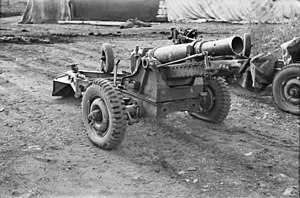| 25-pounder Short Mark I | |
|---|---|
 An Ordnance QF 25-pounder Short in 1944 | |
| Type | Field gun / howitzer |
| Place of origin | Australia / United Kingdom |
| Service history | |
| In service | 1943–1946[1] |
| Used by | Australian Army |
| Wars | World War II |
| Production history | |
| Designed | 1942 |
| Unit cost | £3,300[2] |
| Produced | 1943–1944[3][4] |
| No. built | 213 |
| Specifications | |
| Mass | 1,315 kg (2,900 lb) gun and carriage |
| Barrel length | 49.8 inches (1.26 m) (14.45 calibres) |
| Crew | 6 |
| Shell | Various, with normal (3 charges) and super charge |
| Shell weight | 25 pounds (11.3 kg) |
| Calibre | 3.45 inches (87.6 mm) |
| Breech | Vertical-sliding-wedge |
| Recoil | Hydro-pneumatic, variable |
| Carriage | Two wheel, box trail |
| Elevation | -5° to +40° |
| Traverse | 4° on carriage |
| Rate of fire | 3-4 rpm |
| Muzzle velocity | 1,230 ft/s (375 m/s) |
| Effective firing range | 10,200 yd (9,300 m) |
| Maximum firing range | 11,500 yd (10,500 m) using super charge[5] |
The Ordnance QF 25-pounder Short was an Australian variant of the British Ordnance QF 25-pounder field gun/howitzer. The gun was developed by modifying the 25-pounder's design to improve its mobility during jungle warfare. Development began in 1942, and the weapon first entered service with the Australian Army the next year. It was used by several Royal Australian Artillery regiments during fighting in the South West Pacific Area, before being declared obsolete in 1946.
The development of the Ordnance QF 25-pounder Short was an important achievement for Australia's defence industry, and provided the Army with a weapon suited to conditions in the South West Pacific. Nevertheless, the gun's performance was inferior to that of the standard 25-pounder, and it received a mixed reception from artillerymen.